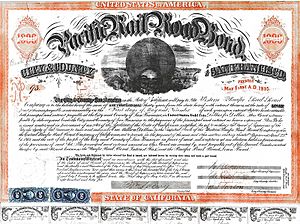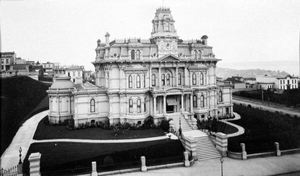Charles Crocker facts for kids
Quick facts for kids
Charles Crocker
|
|
|---|---|

c. 1872 by Stephen W. Shaw
|
|
| Born | September 16, 1822 Troy, New York, U.S.
|
| Died | August 14, 1888 (aged 65) Monterey, California, U.S.
|
| Net worth | $20 million at death in 1888 (1/608th of U.S. GNP) |
| Political party | Republican |
| Spouse(s) |
Mary Ann Deming
(m. 1852; |
| Children | 6, including Charles, George, William |
| Relatives | Edwin B. Crocker (brother) Harry Crocker (grand-nephew) |
Charles Crocker (born September 16, 1822 – died August 14, 1888) was an important American business leader. He was one of the main people who started the Central Pacific Railroad. This company built the western part of the first transcontinental railroad across North America. He also helped take control of the Southern Pacific Railroad with his partners.
Contents
Early Life of Charles Crocker
Charles Crocker was born in Troy, New York, on September 16, 1822. His family was not wealthy. When he was 14, they moved west to Indiana to live on a farm. Charles quickly became independent. He worked on farms, at a sawmill, and in an iron workshop.
At 23, in 1845, he started his own small iron business. He saved money from his work. Later, he used this money to invest in the new railroad business. This happened after he moved to California, which was growing fast because of the California Gold Rush.
Building the Railroads

In 1861, Charles Crocker became one of the four main investors in the Central Pacific Railroad. The other three were Mark Hopkins, Collis Huntington, and Leland Stanford. These four men were known as The Big Four. They worked to build the western part of the First Transcontinental Railroad in North America.
Charles Crocker was in charge of building the railroad. He also led Charles Crocker & Co., a company created just to build the tracks.
Overcoming Challenges in Construction
Building railroads through mountains was very hard. Crocker bought special plows to clear snow from the tracks. But the plows often broke because of ice. To solve this, he had over 40 miles (65 km) of snow sheds built. These were like long tunnels that covered the tracks in the Sierra Nevada mountains. This stopped snow from covering the tracks in winter. This big project cost more than $2 million.
In 1864, Charles asked his older brother, Edwin, to be the lawyer for the Central Pacific Railroad.
Expanding Railroad Control
While the Central Pacific was still being built in 1868, Crocker and his three partners also took control of the Southern Pacific Railroad. This company built the western part of the second transcontinental railroad.
A town in New Mexico, Deming, New Mexico, is named after Charles Crocker's wife, Mary Ann Deming Crocker. In 1881, a silver spike was hammered there. This marked the meeting of the Southern Pacific and the Atchison, Topeka and Santa Fe Railway railroads. This completed the second transcontinental railroad in the United States.
On September 5, 1876, at the Lang Southern Pacific Station in California, Crocker hammered a golden spike. This celebrated the completion of the rail line in the San Joaquin Valley. This new line connected Los Angeles with San Francisco and the First Transcontinental Railroad.
Banking Ventures
For a short time in 1869, Charles Crocker was the main owner of Wells Fargo and served as its president. Later, he bought a controlling share in Woolworth National Bank for his son, William. This bank was then renamed Crocker-Anglo Bank.
In 1963, Crocker-Anglo Bank joined with another bank to become Crocker-Citizens Bank. It was later called Crocker National Bank. This bank no longer exists, as it was bought by Wells Fargo in 1986.
Nob Hill and the Spite Fence
Charles Crocker built a very large house on Nob Hill in San Francisco. He tried to buy a nearby property from his neighbor, Mr. Nicholas Yung, but Mr. Yung refused to sell. In response, Crocker built a very tall, 40-foot fence around three sides of his neighbor's property. This type of fence is called a spite fence.
People tried to challenge the fence in court, but it stayed up for many years. The fence was only removed after Mrs. Yung died and her family sold the property to Crocker's family. After this famous disagreement, building spite fences became illegal in San Francisco.
Crocker's mansion was destroyed in the 1906 San Francisco earthquake. After the earthquake, Crocker's family gave the entire block of land to a charity. This land is now where Grace Cathedral stands.
Charles Crocker's Family Life
In 1852, Charles Crocker married Mary Ann Deming (1827–1889). They had six children together, and four of them lived to be adults:
- Charles Frederick Crocker (1854–1897)
- George Crocker (1856–1909)
- Harriet Valentine Crocker (1859–1935)
- William Henry Crocker (1861–1937)
In 1886, Charles Crocker was badly hurt in a carriage accident in New York City. He never fully recovered and died two years later on August 14, 1888. He was buried in a large mausoleum at Mountain View Cemetery in Oakland, California. This impressive stone building was designed by architect A. Page Brown. At the time of his death, Charles Crocker's wealth was estimated to be between $300 million and $400 million.

Crocker's Descendants
Charles Crocker's family continued to be important.
- His grandson, Charles Templeton Crocker (1884–1948), was a well-known figure.
- His great-great-grandson is U.S. Senator Sheldon Whitehouse of Rhode Island.
| Family of Charles Crocker | |||||||||||||||||||||||||||||||||||||||||||||||||||||||||||||||||||||||||||||||||||||||||||||||||||||||||||||||||||||||||||||||||||||||||||||||||||||||||||||||||||||||||||||||||||||||||||||||||||||||||||||||||||||||||||||||||||||||||||||||||||||||||||||||||||||||||||||||||||||||||||||||||||||||||||||||||||||||||||||||||||||||||||||||||||||||||||||||||||||||||||||||||||||||||||||||||||||||||||||||||||||||||||||||||||||||||||||||||||||||||||||||||||||||||||||||||||||||||||||||||||||||||||||||||||||||||||||||||||||||||||||||||||||||||||||||||||||||||||||||||||||||||||||||||||||||||||||||||||||||||||||||||||||||||||||||||||||||||||||||||||||||||||||||||||||||||||||||||||||||||||||||||||||||||||||||||||||||||||||||||||||||||||||||||||||||||||||||||||||||||||||||||||||||||||||||||||||||||||||||||||||||||||||||||||||||||||||||||||||||||||||||||||||||||||||||||||||||||||||||||||||||||||||||||||||||||||||||||||||||||||||||||||||||||||||||||||||||||||||||||||||||||||||||||||||||||||||||||||||||
|---|---|---|---|---|---|---|---|---|---|---|---|---|---|---|---|---|---|---|---|---|---|---|---|---|---|---|---|---|---|---|---|---|---|---|---|---|---|---|---|---|---|---|---|---|---|---|---|---|---|---|---|---|---|---|---|---|---|---|---|---|---|---|---|---|---|---|---|---|---|---|---|---|---|---|---|---|---|---|---|---|---|---|---|---|---|---|---|---|---|---|---|---|---|---|---|---|---|---|---|---|---|---|---|---|---|---|---|---|---|---|---|---|---|---|---|---|---|---|---|---|---|---|---|---|---|---|---|---|---|---|---|---|---|---|---|---|---|---|---|---|---|---|---|---|---|---|---|---|---|---|---|---|---|---|---|---|---|---|---|---|---|---|---|---|---|---|---|---|---|---|---|---|---|---|---|---|---|---|---|---|---|---|---|---|---|---|---|---|---|---|---|---|---|---|---|---|---|---|---|---|---|---|---|---|---|---|---|---|---|---|---|---|---|---|---|---|---|---|---|---|---|---|---|---|---|---|---|---|---|---|---|---|---|---|---|---|---|---|---|---|---|---|---|---|---|---|---|---|---|---|---|---|---|---|---|---|---|---|---|---|---|---|---|---|---|---|---|---|---|---|---|---|---|---|---|---|---|---|---|---|---|---|---|---|---|---|---|---|---|---|---|---|---|---|---|---|---|---|---|---|---|---|---|---|---|---|---|---|---|---|---|---|---|---|---|---|---|---|---|---|---|---|---|---|---|---|---|---|---|---|---|---|---|---|---|---|---|---|---|---|---|---|---|---|---|---|---|---|---|---|---|---|---|---|---|---|---|---|---|---|---|---|---|---|---|---|---|---|---|---|---|---|---|---|---|---|---|---|---|---|---|---|---|---|---|---|---|---|---|---|---|---|---|---|---|---|---|---|---|---|---|---|---|---|---|---|---|---|---|---|---|---|---|---|---|---|---|---|---|---|---|---|---|---|---|---|---|---|---|---|---|---|---|---|---|---|---|---|---|---|---|---|---|---|---|---|---|---|---|---|---|---|---|---|---|---|---|---|---|---|---|---|---|---|---|---|---|---|---|---|---|---|---|---|---|---|---|---|---|---|---|---|---|---|---|---|---|---|---|---|---|---|---|---|---|---|---|---|---|---|---|---|---|---|---|---|---|---|---|---|---|---|---|---|---|---|---|---|---|---|---|---|---|---|---|---|---|---|---|---|---|---|---|---|---|---|---|---|---|---|---|---|---|---|---|---|---|---|---|---|---|---|---|---|---|---|---|---|---|---|---|---|---|---|---|---|---|---|---|---|---|---|---|---|---|---|---|---|---|---|---|---|---|---|---|---|---|---|---|---|---|---|---|---|---|---|---|---|---|---|---|---|---|---|---|---|---|---|---|---|---|---|---|---|---|---|---|---|---|---|---|---|---|---|---|---|---|---|---|---|---|---|---|---|---|---|---|---|---|---|---|---|---|---|---|---|---|---|---|---|---|---|---|---|---|---|---|---|---|---|---|---|---|---|---|---|---|---|---|---|---|---|---|---|---|---|---|---|---|---|---|---|---|---|---|---|---|---|---|---|---|---|---|---|---|---|---|---|---|---|---|---|---|---|---|---|---|---|---|---|---|---|---|---|---|---|---|---|---|---|---|---|---|---|---|---|---|---|---|---|---|---|---|---|---|---|---|---|---|---|---|---|---|---|---|---|---|---|---|---|---|---|---|---|---|---|---|---|---|---|---|---|---|---|---|---|---|---|---|---|---|---|---|---|---|---|---|---|---|---|---|---|---|---|---|---|---|---|---|---|---|---|---|---|---|---|---|---|---|---|---|---|---|---|---|---|---|---|---|---|---|---|---|---|---|---|---|---|---|---|---|---|---|---|---|---|---|---|---|---|---|---|---|---|---|---|---|---|---|---|---|---|---|---|---|---|---|---|---|---|---|---|---|---|---|---|---|---|---|---|---|---|---|---|---|---|---|---|---|---|---|---|---|---|---|---|---|---|---|---|---|---|---|---|---|---|---|---|---|---|---|---|---|---|---|---|---|---|---|---|---|---|---|---|---|---|---|---|---|---|---|---|---|---|---|---|---|---|---|---|---|---|---|---|---|---|---|---|---|---|---|---|---|---|---|---|---|---|---|---|---|---|---|---|---|---|---|---|---|---|---|---|---|---|---|---|---|---|---|---|---|---|---|---|---|---|---|---|---|---|---|---|---|---|---|---|---|---|---|---|---|---|---|---|---|---|---|---|---|---|---|---|---|---|---|---|---|---|---|
|
|||||||||||||||||||||||||||||||||||||||||||||||||||||||||||||||||||||||||||||||||||||||||||||||||||||||||||||||||||||||||||||||||||||||||||||||||||||||||||||||||||||||||||||||||||||||||||||||||||||||||||||||||||||||||||||||||||||||||||||||||||||||||||||||||||||||||||||||||||||||||||||||||||||||||||||||||||||||||||||||||||||||||||||||||||||||||||||||||||||||||||||||||||||||||||||||||||||||||||||||||||||||||||||||||||||||||||||||||||||||||||||||||||||||||||||||||||||||||||||||||||||||||||||||||||||||||||||||||||||||||||||||||||||||||||||||||||||||||||||||||||||||||||||||||||||||||||||||||||||||||||||||||||||||||||||||||||||||||||||||||||||||||||||||||||||||||||||||||||||||||||||||||||||||||||||||||||||||||||||||||||||||||||||||||||||||||||||||||||||||||||||||||||||||||||||||||||||||||||||||||||||||||||||||||||||||||||||||||||||||||||||||||||||||||||||||||||||||||||||||||||||||||||||||||||||||||||||||||||||||||||||||||||||||||||||||||||||||||||||||||||||||||||||||||||||||||||||||||||||||
See also
 In Spanish: Charles Crocker para niños
In Spanish: Charles Crocker para niños




